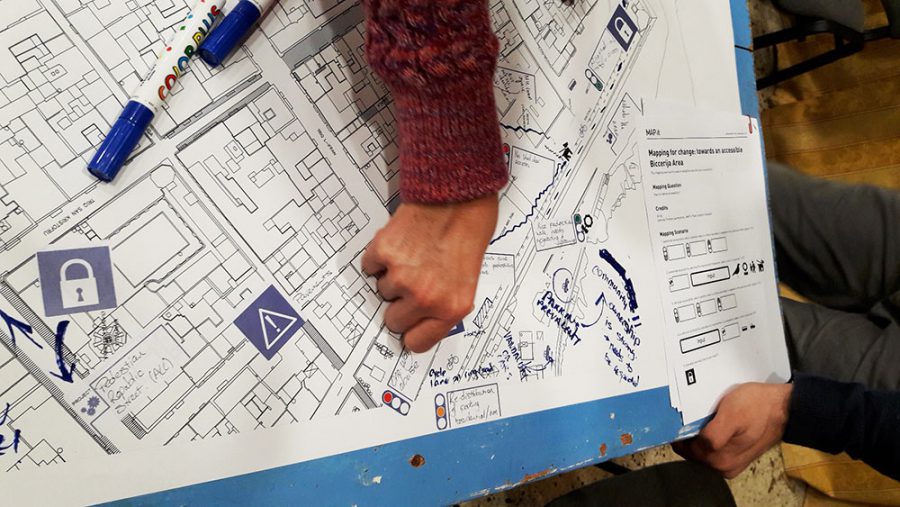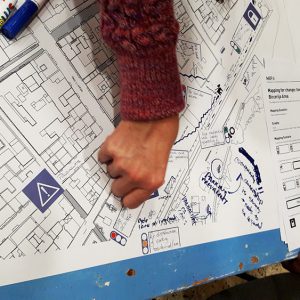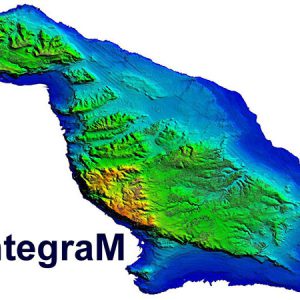Activities
Planning, Pandemic and Participation
Author: Wendy Jo Mifsud, June 2022
Much has already been written about how cities and human settlements can be made more resilient in the context of the current and possible future pandemics. It is striking that the pandemic seems to have given many the chance to stop and observe the city, to appreciate the unprecedented stillness and to attempt to understand what it is that makes a place liveable or otherwise. We are currently witness to a crucial time, whereby spatial planners can be forerunners in the drive to increase the quality of life in cities, since this concept may now be better understood. This is the juncture at which Forester’s (1999) deliberative planning can be attuned to today’s socio-spatial contexts, bringing together the educative and participatory aspects of spatial planning in a continuous learning cycle about society, its concerns and how to address them.
In the light of ubiquitous digital technologies, the requirement to communicate with each other and to organise our societies remains yet. Should more successful participatory planning methods be utilised, there is the potential therefore of spatial planning helping in the formation of a better society; one which fosters the development of social capital across all scales, and which promotes the use of this capital in governance structures. Through participatory planning initiatives such as those organised during the Valletta 2018 Capital for Culture (Figure 1), it can be acknowledged that planners alone do not know the answer to what constitutes a successful community and their role therefore becomes “to create, sustain, and participate in a public, democratic discourse that enables them (and others) to argue persuasively and coherently about contestable views of what is good, right and feasible” (Throgmorton, 1996, p. 54).
Figure 1 A V18 community planning workshop in Valletta
Source: Author
The Covid-19 pandemic brings the matter of good planning into a natural dialectic with good governance. As mitigation and adaptation strategies must constantly deal with an evolving global health situation, the involvement of the public is necessary to respond to concerns which are inherently dynamic and complex. Planners can mobilise the needs of the public by translating them into spatial planning policy and appealing to decision-makers to respect such needs (Lai et al., 2020). In this respect, the introduction of ecosystem services, green infrastructure and urban nature are critical for urban resilience since they support the infrastructural capacity of the city, and essentially, the mental and physical health of city-dwellers (Samuelsson et al., 2020).
Of note however, is the observation that the Covid-19 pandemic can be considered the first in history to have impacted human settlements that should have been in truth equipped to limit the spread of infection (Sonn et al., 2020). The indiscriminate impact of the pandemic is somewhat surprising considering the ravages wrought on Smart, which are managed through sophisticated digital interfaces. The phenomenon becomes clearer when one realises that digital data is segregated within independent private corporations or governmental institutions with no interoperability to allow for the data to be interpreted holistically (Allam & Jones, 2020). Three extensive data sources readily available in cities are transportation cards, mobile phone location data and cashless transaction records; all well placed to contribute to contact tracing and the implementation of isolation measures (Sonn et al., 2020).
Adequate frameworks for data collection and its availability to policymakers, in order to facilitate spatial analysis that can quickly inform policy, are therefore crucial (Campagna, 2020). The SIntegraM Project (Figure 2) has been recently implemented in Malta and is a positive initiative to achieve spatial data harmonisation for the Islands (Formosa, 2017). Thus, both in the case of physical measures to improve urban resilience and digital means of strengthening city management, the improvements that can be made as a result of the current pandemic shall be an investment for cities to better their response to future emergencies (Megahed & Ghoneim, 2020). Such improvements shall however have long-term positive socio-economic impacts on the daily lives of the communities who make cities their home, while mitigating the negative effects of crises. This highlights the importance of contextuality and the relevance of community participation in spatial planning (Campagna, 2020).
Figure 2 An image from the SintegraM Project
Source: https://www.um.edu.mt/newspoint/news/2017/02
In conclusion, the Maltese have adopted an entrepreneurial approach to dealing with the Covid-19 pandemic, many looking for support from friends and family, others looking towards state aid or assistance from the many voluntary organisations on the Islands (Baldacchino, 2020). Some have nonetheless suffered financial losses brought about by the subsequent recession, with the related long-lasting effect on their psychological wellbeing. Adaptation strategies are essential to deal with these negative impacts and should not be limited only to fiscal incentives. Briguglio (2020) addresses this challenge by promoting adult learning, volunteering, and physical exercise as complementary measures, while advocating the retention of practices that have proven beneficial and which are sustainable in the long term.
People’s relationship with space is rooted in tradition. In Malta, such tradition is often of a communitarian nature, either when enjoying the Islands’ picturesque waterfronts and beaches, or when gathering to celebrate on the feast day of the patron saint of a locality. The circumstances of the Covid-19 pandemic have forced many to rethink their relationship with their community and with the spaces they inhabit. The complex socio-spatial relationships that many took for granted will be reconsidered in the forthcoming months, as a new reality is carved from the longstanding normal. Planners must sensitively respond to these efforts on behalf of the community, and though planning for an uncertain future is inherent to a planner’s role, this new dynami-city is a particularly challenging test of our skills that must be embraced.
References
Allam, Z., & Jones, D. S. (2020). Pandemic stricken cities on lockdown. Where are our planning and design professionals [now, then and into the future]? Land use Policy, 104805.
Baldacchino, G. (2020). Coronavirus and Malta: weathering the storm.
Briguglio, M. (2020). Beyond the economy.
Campagna, M. (2020). Geographic Information and Covid-19 outbreak: does the spatial dimension matter?
Forester, J. (1999). The deliberative practitioner: Encouraging participatory planning processes. MIT Press.
Formosa, S. (2017). Sensing the SIntegraM: a two-decadal endeavour for spatial data harmonisation and governance.
Lai, S., Leone, F., & Zoppi, C. (2020). Covid-19 and spatial planning: a few issues concerning public policy.
Megahed, N. A., & Ghoneim, E. M. (2020). Antivirus-built environment: Lessons learned from Covid-19 pandemic. Sustainable Cities and Society, 102350.
Samuelsson, K., Barthel, S., Colding, J., Macassa, G., & Giusti, M. (2020). Urban nature as a source of resilience during social distancing amidst the coronavirus pandemic.
Sonn, J. W., Kang, M., & Choi, Y. (2020). Smart City Technologies for Pandemic Control without Lockdown.
Throgmorton, J. A. (1996). The argumentative or rhetorical turn in planning.


